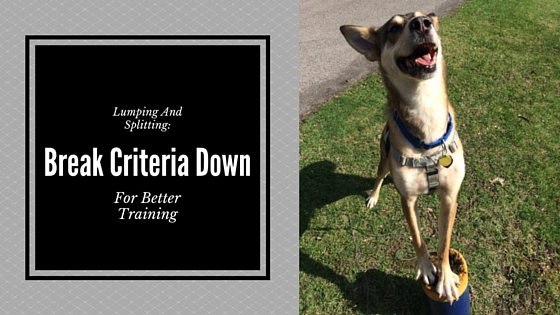Lumping And Splitting: Break Criteria Down For Better Training

Most dogs learn the same way. Wait, really? Let’s back up. The difference is not in the learning; it’s in the training. I’m sure you’ve experienced that each breed requires training specific to their tendencies, and each pup can be as individual as each of us. By paying attention we can even recognize that there are anomalies with in a breed—like the Border Collie that doesn’t stalk or isn’t sensitive to movement, or the Bulldog or Frenchie that happily walks without the passive aggressive Buddah stops. Beyond even this, we know to change our training approach when we witness behavioral issues such as fear, anxiety, or aggression. And yet, it remains true that dogs still learn the same way! Surprising?
Similar, Yet Different
Each dog is different. In the same way that students excel in certain subjects and struggle in others, dogs do, too. I believe this happens because of “Lumping and Splitting”. The term lumping is asking a dog to learn multiple aspects of training at the same time by introducing the behavior simultaneously. Splitting is taking one behavior and teaching it through gradual and incremental steps. All dogs eventually learn the “Triple D’s” (distance, duration, and distraction) but the approach is what must differ for each dog.
Lumping
For some dogs when it comes to understanding the basics of a stay, they’ll get an easy “A”. However the moment a distraction is introduced the house of cards falls apart. This often happens when the trainer tries to muscle through and “lump” new criteria together, causing the dog to fail. Although “splitting” up the stay itself and introducing distractions in tiny itty bitty increments may take a bit longer, the lasting effects in the overall behavior will be golden! Combining the Triple D’s too quickly is the lumping that so often causes big failures resulting in frustration for the dog and for your client.
I sometimes see it when a new client shows me they’ve been teaching a stay by extending their hand like a traffic cop while slowly backing away from their dog as if it were a bomb, chanting “staaaaaay, staaaayyyyyyy” which inevitably results in failure, because they’ve increased the distance too much too soon.
One Step at a Time
Let’s look at the same behavior split it up into smaller pieces working each of the D’s one at a time. First: duration. Reward your client’s dog with a treat for nothing more than sitting in front of you. If you can get the pup to stay in the sit for 10 seconds in between treats then it would be an appropriate time to move onto the next D!
Second: distance. The dog will always dictate when he’s ready for more distance by his success in his stay. With some dogs you might find leaning back is plenty of distance initially. The more you breakdown the criteria, the more successful the dog will be.
Lastly: distractions. Using kissy noises or thigh pats incrementally added can be plenty of distraction at first. It’s critical to keep rewarding each small distraction. This will help ensure your rate of success without allowing the dog to fail.
Donna Hill has an outstanding video that thoroughly explains this concept:
Splitting can help you teach any behavior. A great trainer will be able to identify when to make like a tree and split!
Get Dog Training Business Tips!
Receive valuable dog training business tips and resources every week! Subscribe to The Modern Dog Trainer now by submitting your name and email below.
[mc4wp_form]



